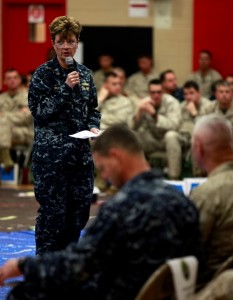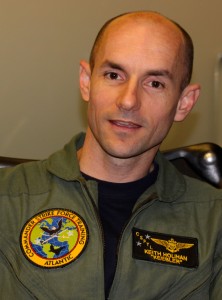2013-06-04 Bold Alligator 2013 was a synthetic training exercise.
This meant that the key combat assets were networked and operated together interactively in response to “events” generated by the scenarios and challenges set by the exercise.
Bold Alligator 2012 was a live exercise as will be Bold Alligator 2014, and the live exercises draw upon the synthetic and vice versa in shaping a continuous combat learning process.

Second Line of Defense had a chance to talk with two key participants in the exercise who were key to the “synthetic” part of the synthetic exercise.
The first was Michael “Odie” Ogden, Assistant Chief of Staff (N9) for Synthetic Training and Technologies. Ogden is the “guru” for Commander Strike Force Training Atlantic on “synthetic exercises.”
The second was CDR Keith “Keebler” Holihan, Director of Operational Plans (N53) for Strike Force Training Atlantic. While Ogden discussed the broad approach of synthetic exercises, Holihan provided some comments with regard to where the training was headed which drew upon such training.
The broad strategic direction for “synthetic” training is from operating much like Pong to now operating like X Box.
Whereas a decade ago, such training was based on computer screen and simulations now warriors are at their posts, and use their weapon systems and communication systems to work with the assets of the force to simulate operations. It is a shift from simulated activity to synthetic interactive operations. This means that the approach allows significant interactive or fleet wide operational training, rather than simply testing skills by single purpose operators.
The potential for such an approach to shape procurement could well be significant.
Platforms will continue to be purchased as the enablers of systems, but determining the interactive capabilities (for no platform fights alone) can clearly be shaped by anticipated effects from the insertion of projected new platforms or systems.For example, in this exercise they inserted Scan Eagle to see what difference it what make it in different situations.
SLD: What would say the main benefit of synthetic training is?
Ogden: It clearly allows a more cost effective way to train in fleet processes and procedures. Obviously, there are several key things one needs to do live training for and there is no substitute synthetically, such as landing on carrier decks.
As for process and procedures in training in a number of warfare areas, whether combined or individually, synthetic training works very well. For staff training, it works very well; for you have no weather limitations and you have no asset limitations, which means that you can provide solid training time to work out better staff working procedures and processes fleet wide.

One of the advantages we have is that by getting into the shipboard systems, were able to use the radar and sonar systems, use the C5ISR systems, generate message system “chat” and use the real world SATCM and UHV line of site just as if they were at sea.
For all intents and purposes, the warriors are operating as if they were in the real world.
This means that we can plug in distance-deployed assets to plug into the exercise and work with the ships, which are operating dockside in the exercise. We can link Atlantic and Pacific fleets, for example. This allows us to plug in allies who operate on their ships overseas but can plug into the integrated training network.
This gives us great flexibility and an ability to expand the exercise beyond local participants.
SLD: We have a younger generation very comfortable with a computer based learning process. It also allows different cultures to interact and to shape interactive learning processes as well. How much interactivity do we see in the shaping function?
Ogden: When you bring in the coalition partners, they often bring a different way of war fighting or different processes. This environment allows us to smooth the working relationship and gives us the opportunity in a very controlled environment to sort out convergence of operational styles to enhance overall performance of the coalition.
SLD: You have been doing this for a while. How is it different in 2013 than a decade ago?
Ogden: It’s night and day. Instead of sitting in a room with a fake display that’s being fed by a simulation, we’ve got people onboard the ship in front of the real systems connected worldwide. The difference is between Pong and Xbox, that’s a comparison I use because that’s really what we’re doing a dozen years ago was Pong. And right now, it’s about real as we can possibly make it.
SLD: CDR Holihan, what is role in the exercise and in Strike Force Training Atlantic?
Holihan: I’ve been on the staff here for about two years, and was actually the lead planner for Bold Alligator 2012. I have had the opportunity to see our live and synthetic exercise. In last year’s exercise which was live had a synthetic component overlaid on top of it, which I think is another interesting area to explore as time goes on.
And this year’s exercise is predominately synthetic. We have our live assets time in at the appropriate places.
In other words, the last two years have been dedicated to Bold Alligator for the planning from the initiation of the concept for the exercise itself, what training objectives we were trying to accomplish, any specific integration pieces, whether it be developmental, innovative pieces, initiatives. We worked on the whole planning process up to execution.

And during the execution phase, I’m the deputy director for the blue side, for the Navy. I focus on working the coordination among the different simulation centers for the training audience shapes the training opportunities.
SLD: You have done this for two years. What do you see is the overall objective?
Holihan: Put in its simplest formulation it is to create the conditions in the Blue-Green team can work more effectively to shape a single naval battle capability. This is an aspiration, and not yet a reality. Getting the strike and amphibious fleets to work more effectively is a clear goal.
We’ve really focused on the planning and the development of the exercise to identify gaps or seams that may exist between CSG operations, ESG operations with the MEB.
SLD: A core challenge for the single naval battle in the kind of scenario you tested this year is operating in a commercial operational environment as well. The impact of operating close to commercial air and maritime space poses additional challenges.
Holihan: It clearly does and is a concern, which we are addressing. We’ve got some high traffic commercial areas that are running in the background for the whole simulation. Our forces are challenged commercial surface ships and commercial air that zips across through the area, too. So, the exercise replicates actually fairly well in the real world, and those considerations.
SLD: Are you seeing more creativity and more focus from the surface fleet on their ability to support the Amphibious Strike Group?
Holihan: We are. And that clearly is one of the goals of these exercises, to get better integration of the strike force assets with the amphibious assets.
We have tended to rely on separate areas of operation.
If we were really a fully integrated Naval force, then why do we have to have separate distinct areas? We are clearly working on new ways to bring these forces together in a more integrated fashion. Single battle group is the aspiration, but we clearly need to move more towards the reality of that concept.
And the exercise allows the different naval elements to learn more effectively what the different assets can contribute beyond whatever their primary task has been.

